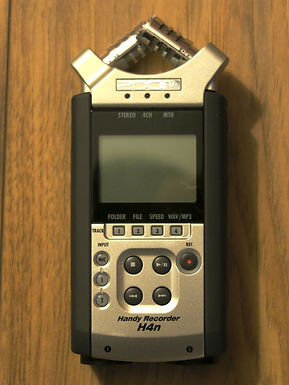Capturing quality audio begins with the recording device. It’s most important to choose an audio device that you are comfortable with. But first let’s start with some basic information. I’m sure you’ve heard of MP3 or M4A files, but what’s a WAV file and why does it matter? WAV files are uncompressed, raw audio files. They’re the type of file you want to start with. MP3/M4A files are compressed files, that have been digitally altered to reduce the file size, taking along dynamic range and frequency response with it. They are output files that are used to share your final product to a wide audience, while WAV files are the raw recordings that you use to edit with. Another thing to keep in mind is how many inputs, or sound sources, will you need to capture your audio? Will you need just a single microphone or will you need two microphones? Or a microphone and a guitar? This is an important question to consider when selecting your recording device because it will determine how many input channels your device should have.

Portable Digital Audio Recorders
The first device you would want to consider to capture high-quality audio is a portable digital audio recorder. These handy devices can record WAV and MP3 files directly to SD and microSD memory cards. Some are small enough to fit in a pocket, like the Zoom H1, others like the Zoom H4n or Tascam DR-40 are handheld devices. These are great tools for recording audio only and are widely used in both beginner and even some professional settings.
Video Cameras and DSLRs
If you are also recording video for your interview, you may want to record your audio directly to the camera. It’s very common for people to use one of the recorders named earlier along with a video camera and sync the audio later in the editing process. This is because it gives the user more control over the audio settings in some instances. One of those instances is using a DSLR camera. Many DSLRs have an external microphone jack that you can use to plug in a microphone directly on your subject, rather than using the harsh built-in microphone on the camera. This is a convenient way to capture quality audio to go along with your video. Keep in mind, the audio interface can be frustrating and difficult to manipulate on a DSLR because it all resides within the camera’s menus and sometimes doesn’t use any external buttons to control functions. It also may not record audio is the WAV format that was discussed earlier. Regardless, if you don’t have the available equipment, funds, and are familiar with a DSLR, this is a good choice for you. The same principles apply toward many other consumer-level video cameras, although some may have external audio functions which will make using it a simpler process.

Zoom H4n
Portable Digital Audio Recorder
Nikon D750
DSLR

Now, let’s review a few common devices that you could use.
Topic 1 - Recording Devices
A little bit of background...
Learning about devices

Panasonic HPX-170
Professional Video Camera